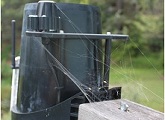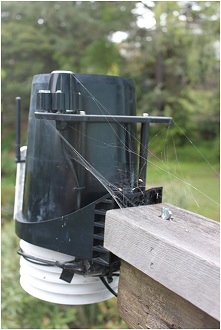October Newsletter 2012 - Cleaning your Davis Weather Station (or many others for that matter)
October Newsletter 2012 - Cleaning your Davis Weather Station (or many others for that matter) On behalf of Instrument Choice I competed in the 53km Trailblazer challenge, which is a challenging and beautiful hike/run through the Adelaide hills. So far we have raised $350 for Operation Flinders and to top it off we completed the race with a personal best time of 8 hours 58 minutes! Last weekend the Instrument Choice team hit the Port River Dolphin Sanctuary for a kayaking adventure through the mangroves, it was a wonderful morning with plenty of bird and dolphin sittings to keep everyone happy. I would like to share a wonderful article I saw a few months ago on the Davis Instruments, Weather Club E-news (http://www.davisnet.com/news/enews/e_news_archive/2012-06.asp) it details how you should clean and care for your Davis weather station (or many other types of weather station for that matter) and with spring upon us now is the perfect time to do it. Remember; if you have any questions regarding tests you need to conduct or specific instrumentation please give us a call.Until next month... Tyson Grubb |
"Today (04/12/2012) in the San Francisco East Bay, we had some vigorous rain-cells. At my station in Orinda, my Vantage Pro2 recorded a peak rainfall rate of 4.03 inches (102.3 mm) per hour. In the week of dry weather before this storm, spiders had 'occupied' the ISS, but surely rain of this severity would have cleaned off all that - right?
The spider webs where a bit thinned from the pounding, but still tenaciously attached to the collector cone and sensor tray. I couldn't resist and grabbed my camera. For fun, I also took a photo of my Vantage Pro2 console showing the peak rate for the day - so there can be no doubts!!" Edouard's spider webs weren't bothered in the least by a good rain shower. Thanks for the reminder, Edouard. It is our spring habit to tell our weather station owners to develop the spring habit of cleaning their station (and not with a good rain shower).
Spring is the time to get out there with a damp cloth and banish bugs, webs, droppings, leaves, and dust from your integrated sensor suite. (Southern hemisphere readers, remember this in September!)
Step one is to wipe down the outer surfaces of your integrated sensor suite (ISS) with a clean damp cloth.
Next, clean the rain collector.
Vantage Pro2: To clean the rain collector cone on a Vantage Pro2, you should first unplug the RAIN sensor from the SIM to avoid false readings from cleaning. Separate the cone from the base by turning it counter-clockwise. Use a soft, damp cloth to remove any debris from the cone, debris screen, and tipping bucket. Use pipe cleaners to clean the funnel hole in the cone and drain screen in the base. When all parts are clean, rinse with clear water.
Reattach the cone and replace debris screen.
Vantage Vue: To clean the rain collector on a Vantage Vue, use a damp soft cloth to remove any debris from the rain collector and debris screen. Use pipe cleaners to clear any debris remaining in the screen. When all parts are clean, rinse with clear water. You may also need to clean the tipping spoon assembly. Remove it from the base by unscrewing the thumbscrew and sliding the assembly down and away from the base. Use a clean, damp cloth to remove any debris, being careful not to damage any moving parts or scratch the spoon. Rinse with clear water and replace the assembly. To clear any false readings created by cleaning, press RAIN on your console until the selection arrow indicates RAIN DAY. Press 2ND and then press and hold CLEAR until the numbers stop flashing and turn to 0.0.
Then wipe down the outer surfaces of the radiation shield; inspect it and clean if necessary. Don't spray it down or use excessive water as this could damage the sensors.
Vantage Pro2: Remove the rain collector cone, then use a Philips head screwdriver to loosen the three 4" (100 mm) screws holding the radiation shield plates together. Take care to maintain the order and orientation of the plates as you carefully separate them. Remove any debris from inside the shield with a clean, damp cloth. Reassemble in the same order and tighten the 4" screws.
Vantage Vue: To clean insects or debris from inside the shield, use a Philips head screwdriver to loosen the two 2 ½" (64 mm) screws holding the radiation shield plates together. Taking care to maintain the order in which the five plates are assembled, separate the plates and remove any debris. Reassemble the plates in the same order and replace and tighten the screws.
All this information is in your ISS manual, also available in the weather support section of our web site:
Vantage Pro2 or Vantage Pro2 Plus Integrated Sensor Suite manual. If your ISS lives in a very "buggy" or "birdy" place, you may have to repeat the process several times a year. Regardless of the bugginess level, however, every ISS should get a good inspection and cleaning in the spring. Whatever you do, don't be tempted to spray bug killer on your ISS! | |||


 "In the afternoon, I checked the rain gauge and . .nope!
"In the afternoon, I checked the rain gauge and . .nope!